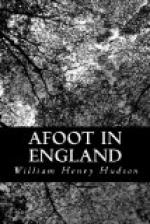A similar trick was played by my mind about Stonehenge. As a child I had stood in imagination before it, gazing up awestruck on those stupendous stones or climbing and crawling like a small beetle on them. And what at last did I see with my physical eyes? Walking over the downs, miscalled a plain, anticipating something tremendous, I finally got away from the woods at Amesbury and spied the thing I sought before me far away on the slope of a green down, and stood still and then sat down in pure astonishment. Was this Stonehenge—this cluster of poor little grey stones, looking in the distance like a small flock of sheep or goats grazing on that immense down! How incredibly insignificant it appeared to me, dwarfed by its surroundings—woods and groves and farmhouses, and by the vast extent of rolling down country visible at that point. It was only when I had recovered from the first shock, when I had got to the very place and stood among the stones, that I began to experience something of the feeling appropriate to the occasion.
The feeling, however, must have been very slight, since it permitted me to become interested in the appearance and actions of a few sparrows inhabiting the temple. The common sparrow is parasitical on man, consequently but rarely found at any distance from human habitations, and it seemed a little strange to find them at home at Stonehenge on the open plain. They were very active carrying up straws and feathers to the crevices on the trioliths where the massive imposts rest on the upright stones. I noticed the birds because of their bright appearance: they were lighter coloured than any sparrows I have ever seen, and one cock bird when flying to and fro in the sunlight looked almost white. I formed the idea that this small colony of about a dozen birds had been long established at that place, and that the change in their colouring was a direct result of the unusual conditions in which they existed, where there was no shade and shelter of trees and bushes, and they were perpetually exposed for generations to the full light of the wide open sky.
On revisiting Stonehenge after an interval of some years I looked for my sparrows and failed to find them. It was at the breeding-season, when they would have been there had they still existed. No doubt the little colony had been extirpated by a sparrow-hawk or by the human guardians of “The Stones,” as the temple is called by the natives.
It remains to tell of my latest visit to “The Stones.” I had resolved to go once in my life with the current or crowd to see the sun rise on the morning of the longest day at that place. This custom or fashion is a declining one: ten or twelve years ago, as many as one or two thousand persons would assemble during the night to wait the great event, but the watchers have now diminished to a few hundreds, and on some years to a few scores. The fashion, no doubt, had its origin when Sir Norman




